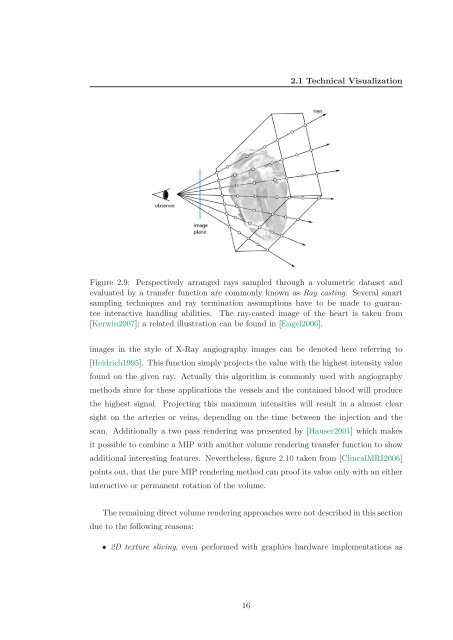Master's Thesis - Studierstube Augmented Reality Project - Graz ...
Master's Thesis - Studierstube Augmented Reality Project - Graz ...
Master's Thesis - Studierstube Augmented Reality Project - Graz ...
Create successful ePaper yourself
Turn your PDF publications into a flip-book with our unique Google optimized e-Paper software.
2.1 Technical Visualization<br />
Figure 2.9: Perspectively arranged rays sampled through a volumetric dataset and<br />
evaluated by a transfer function are commonly known as Ray casting. Several smart<br />
sampling techniques and ray termination assumptions have to be made to guarantee<br />
interactive handling abilities. The ray-casted image of the heart is taken from<br />
[Kerwin2007]; a related illustration can be found in [Engel2006].<br />
images in the style of X-Ray angiography images can be denoted here referring to<br />
[Heidrich1995]. This function simply projects the value with the highest intensity value<br />
found on the given ray. Actually this algorithm is commonly used with angiography<br />
methods since for these applications the vessels and the contained blood will produce<br />
the highest signal. <strong>Project</strong>ing this maximum intensities will result in a almost clear<br />
sight on the arteries or veins, depending on the time between the injection and the<br />
scan. Additionally a two pass rendering was presented by [Hauser2001] which makes<br />
it possible to combine a MIP with another volume rendering transfer function to show<br />
additional interesting features. Nevertheless, figure 2.10 taken from [ClincalMRI2006]<br />
points out, that the pure MIP rendering method can proof its value only with an either<br />
interactive or permanent rotation of the volume.<br />
The remaining direct volume rendering approaches were not described in this section<br />
due to the following reasons:<br />
• 2D texture slicing, even performed with graphics hardware implementations as<br />
16





